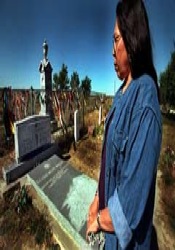Native peoples re-claim Mt. Rushmore in a 30 year commemoration ceremony which also honored women of the red power movement.
 |
|
by Catherine Limcaco/POOR Magazine Race, Poverty and Media Justice Intern "We want to remove their faces", proclaimed Quanah Brightman. Quanah was of one of the many activists in attendance at the Mount Rushmore Reunion that took place on August 29th 2008 in South Dakota. As people commemorate and remember the land that Mount Rushmore covers, it is surprising that many do not know another silenced story about the mountain: Thomas Jefferson, Abraham Lincon, Theodore Roosevelt , and George Washington have nothing to do with it. In many historic accounts that range from the Great Plagues to 9/11, each record is written and then distributed by a publisher. Each publisher upholds different standards and criteria when choosing what events are important for the public to know and what events should be forgotten or in many cases, buried. If only people read between the lines in those history books. The Hearst Family is one of those families that represent the closest thing the U.S. has to corporate royalty in this country. William Randolph Hearst was the forefather of the white-owned, rich-people controlled newspaper industry and his great granddaughter Patty known for her scandalous run-in with the law. The man behind the legacy is George Hearst--a man devoted to discovering (colonizing) the best mines in the country as well as investing (stealing) from the most profitable land. George Hearst was not only able to provide a future of wealth and privilege for his family, but he gave the U.S. a memento that would stand the test of time. On August 29, 1970, the Sioux peoples and many supporters made the mark on Mount Rushmore, an iconic landmark in the United States provided by George Hearst. The Black Hills is a sacred site that is significant to the Sioux culture. In fact, the area that Mount Rushmore inhabits is sacred to the Sioux. In an effort to take back their land, the Sioux stabbed their flag reading "SIOUX INDIAN POWER" into the heart of Mount Rushmore. Within moments, many--especially the media--were attacking the Sioux for "disrespecting" a monument so powerful as Mount Rushmore. Unfortunately, the media didn't know better as well. The Hearst Family were pioneers in the corporate news industry at the time; could it be that they prevented the REAL story from coming out? "This is a national movement for the public," says Linda Roberts, of United Native Americans Inc. As a Chickanmauga Cherokee, Linda is an example that this problem just doesn't affect the Sioux people. Linda says, "All Native people, we are all responsible for protecting these resources." The 2008 event also acted as a memorial to women like Linda, women of the red power movement. The published history of Mount Rushmore disguises the true story of the Black Hills. When George Hearst purchased the mine under the Black Hills, he devoured all it represents and the gold that could be found there. George Hearst was not the only one at fault; the government has their hand in this invasion signing a document entitled The Fort Laramie Treaty which they never honored. An excerpt from the Fort Laramie Treaty
From this day forward all war between the parties to this agreement shall forever cease. The government of the United States desires peace, and its honor is hereby pledged to keep it. The Indians desire peace, and they now pledge their honor to maintain it. And the government know they did it too. The Sioux people were offered 600 million dollars by the federal government, but they refused claiming that the land is sacred and not for sale. How did "the heart of everything" that the Sioux represents become a "National shrine of Democracy?" The silenced story reads more like a mockery of Democracy. |



